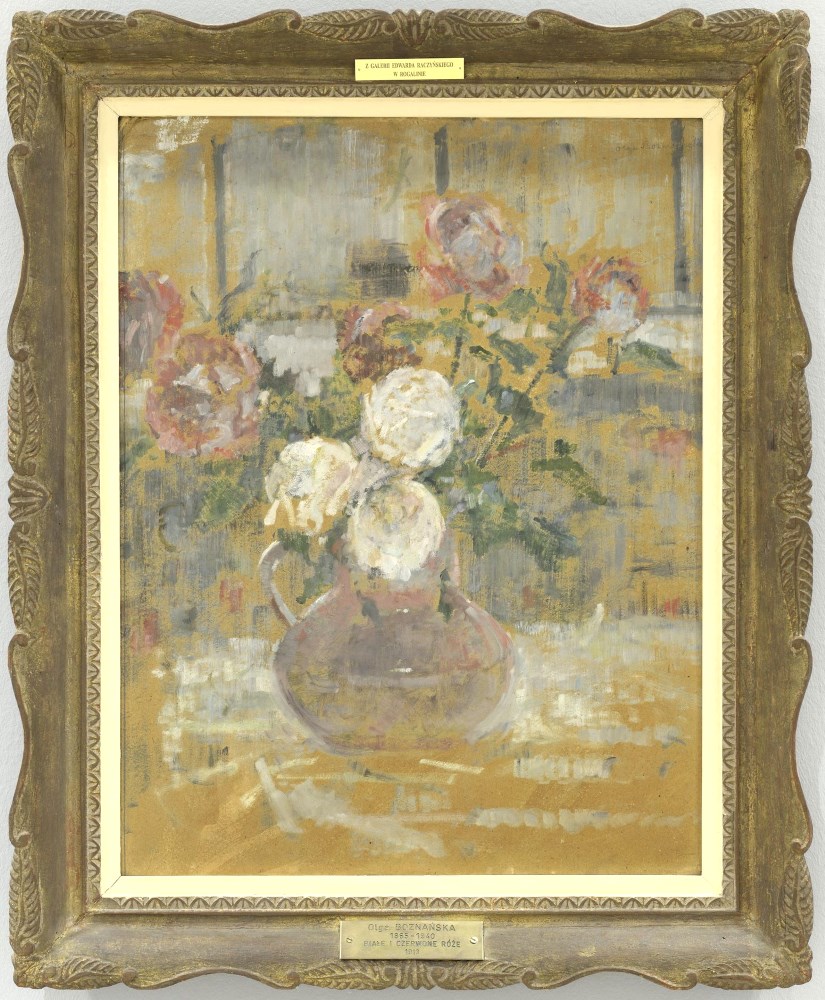Description:
Olga Boznańska’s (1865-1940) education started with private drawing lessons, followed by attending the Baraniecki Course for Women in Krakow. As a woman, she could not be a student at the Academy. An important stage of her education was her stay in Munich and her visits to European museums, where she was amazed by Velázquez, Monet and Whistler. Her goal was Paris, where she settled down and opened a studio after achieving first successes at exhibitions throughout Europe. She painted landscapes, still lifes, interior scenes and moody portraits, for which she became famous.
Description of the painting:
The painting discussed is currently being exhibited at the Polish Painting Gallery of the National Museum in Poznan. Edward Aleksander Raczyński probably bought it in 1914 at the Society of Friends of Fine Arts in Krakow *. During his time, he adorned a small room in the Rogalińska Gallery, and later, thanks to Roger Raczyński, he completed the presentation of other works of the artist in the largest room dedicated solely to Polish painting.
Still lifes, along with portraits, are among the most numerous and at the same time the most intimate works of Olga Boznańska, considered the most outstanding European artist of her time. Her French mother introduced her to the secrets of art, taking up drawing as an amateur. Later, she attended classes at the studios of Kazimierz Pochwalski, Antoni Piotrowski and at the Higher Courses for Women named after Adrian Baraniecki in Krakow. From 1886 she studied at the private school of Karol Kricheldorf in Munich, as well as in the studios of Wilhelm Dür and Paul Neuen there. After a short stay in Krakow, she returned to Munich, where she perfected her craft on her own. In 1898 she moved permanently to Paris, where she died in 1940.
During her studies in Munich, she exhibited her works at the Cracow Society of Friends of Fine Arts and at numerous shows in Munich, Berlin, Vienna and other European cities. Very early noticed, especially abroad, she developed her own, unique style. It had a great influence on the younger generation of Polish artists from the „KP” group who, in the twenties of the twentieth century, were gathered in Paris around Józef Pankiewicz. The difference between the more valued by them Boznańska and their Parisian guide Józef Pankiewicz was perfectly captured by Jerzy Wolff, who wrote that Pankiewicz’s art „… is a bridge connecting us with the art of Europe, Boznańska’s art is our contribution to that art.”.
According to the friends of Boznańska – on the window sills of her Parisian studio, bouquets of marigolds, anemones and roses almost always slowly faded away. Never a linden tree, Boznańska didn’t like it. She liked to paint flowers the most when they began to wither, when the intensity of the color disappears. *** Such white and pink roses can be seen in the Rogaliński painting. We see them in full bloom with petals slowly falling. Their fading color palette is complemented by muted pink-violet reflections on the glass vase and broken blue-gray whiteness of the window sill and rhythmically divided background. The rhythm is set by gray vertical and horizontal lines, reminiscent of the sash of the large window in the Krakow atelier of the artist – just completed according to the project of Franciszek Mączyński and the instructions of Boznańska: “The panes in the windows must remain single, (…) because double glazing takes away the painting value of light” ***. The geometrized texture of the background is softened by the roundness of the vase and the buds of roses, as well as the tremulous texture of green-gray leaves and diagonally inclined stems. And all this melted in the background of warm toned cardboard and animated by touches of light on the handle and handle of the vase.
As a result, the title roses create a unified optical phenomenon with the surrounding space, immersed “in its own atmosphere” contained in the plane of the image. The quote mentioned in the previous sentence comes from a letter of the artist to her friend Julia Gradomska in 1909, in which we also read: “[…] My paintings look wonderful, because they are true, they are honest, because they are gentlemanly, there is no pettiness, no manners, no blague. They are quiet and lively and as if a light veil separated them from the onlookers”. These words, referring to the works presented by Boznańska at the exhibition of women painters at Le Petit Musée Beaudouin in Paris, also fully capture the atmosphere of the mentioned still life.
The artist, observing carefully and “tenderly”, left us in her paintings an answer to the question of the relationship between the captured object and the surrounding reality. In this case, it was conveyed through the harmony of shapes, colors and space. The truth about the painted motif converges here with her ethical and blague-free approach to art. Boznańska devoted her whole life to this, searching for painting and color expression means that would be consistent, also emotionally with the presented subject.


